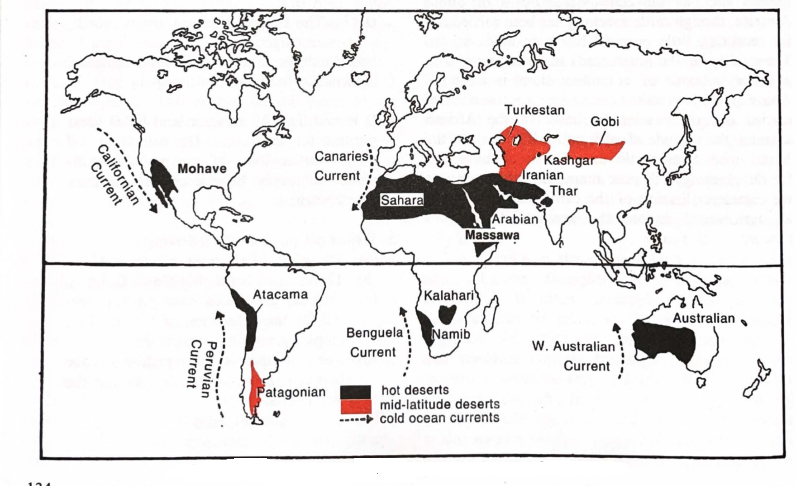-
10 Jan 2025
GS Paper 1
Geography
Day 35: "Deserts are often located on the western coasts of continents due to the combined effects of ocean currents, wind patterns, and atmospheric pressure." Explain. (150 words)
Approach
- Briefly introduce the deserts and acknowledge the observation.
- Explain the combined effects of ocean currents, wind patterns, and atmospheric pressure.
- Conclude Suitably.
Introduction
Deserts are characterized by extremely low rainfall and high evaporation rates, making them some of the driest regions on Earth. The major hot deserts of the world are located on the western coasts of continents between latitudes 150 and 300N and S. This phenomenon is the result of the combined effects of cold ocean currents, wind patterns, and atmospheric pressure systems.
Body
Role of Cold Ocean Currents
- Cooling Effect: Cold ocean currents like the Humboldt Current (off South America) and Benguela Current (off southern Africa) cool the air above them.
- Moisture Loss: As air moves over these currents, its capacity to hold moisture decreases, reducing the likelihood of precipitation.
- The Atacama Desert in Chile, one of the driest places on Earth, is influenced by the cold Humboldt Current.
- The Namib Desert in Namibia experiences similar conditions due to the Benguela Current.
Role of Wind Patterns
- Trade Winds: Trade winds blow from east to west in the subtropics. As they travel over land or the ocean, they lose much of their moisture before reaching the western coasts. This results in dry air masses over these regions.
- The Sahara Desert in northern Africa is influenced by easterly trade winds that prevent moisture from reaching inland areas.
- Offshore Winds: Coastal winds in these areas often blow from land to sea, further preventing the moist ocean air from reaching inland. This reinforces the dry conditions along the western margins.
- The Namib Desert is influenced by easterly trade winds that prevent moisture from the Atlantic Ocean from reaching the land.
Role of Atmospheric Pressure
- Subtropical High-Pressure Belts: Western coastal deserts are typically located between 20° and 30° latitudes, where the subtropical high-pressure zones dominate.
- These zones are characterized by descending air masses that warm up as they descend. The warming process inhibits cloud formation and precipitation, leading to arid conditions.
- The Sonoran Desert in North America lies in the subtropical high-pressure zone, which contributes to its extreme aridity.
- The Kalahari Desert in southern Africa is similarly influenced by these descending air masses.
- These zones are characterized by descending air masses that warm up as they descend. The warming process inhibits cloud formation and precipitation, leading to arid conditions.
Conclusion
The formation of deserts on the western coasts of continents is a result of the interplay between cold ocean currents, easterly trade winds, and subtropical high-pressure zones. These factors combine to create extremely dry and arid conditions in these regions. Understanding these dynamics is crucial not only for studying Earth's climatic systems but also for addressing challenges like desertification and its impact on human settlements.





